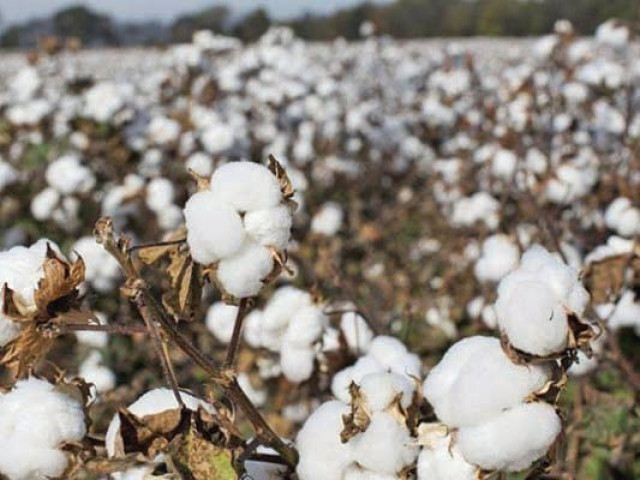Cotton sector cries for policy focus
Output falls as sector continues to suffer from operational inefficiencies

The Cotton Vision 2015, launched in 2011 during the tenure of Pakistan Peoples Party (PPP) government, had envisaged that cotton production would jump from 10.6 million bales to 20 million bales in 2015 – or even earlier. That did not happen.
In fact, the cotton production in 2015 tanked to 10 million bales or just half the targeted volume. This speaks volumes about the quality of “visions” that policymakers continue to present to please the government of the day.
The recently released State Bank of Pakistan’s annual State of the Economy report for FY20 includes a graphic depiction of the sorry state of affairs in the cotton sector. Quoting Federal Committee on Agriculture’s statistics, an infographic in the central bank report shows comparative outputs and yields of two major crops – sugarcane and cotton.
The sugarcane output shows a slow but steady rise from the year 2000 to 2020. During the 2000s, the additional output gain each year is less noticeable. But from FY11 (when agriculture was devolved fully as a provincial subject through the 18th Constitutional Amendment) to FY20, the output gains become all the more noticeable.
On the other hand, between 2000 and 2010, the yearly increase in cotton output remained quite appreciable (except for in FY10 when widespread floods hit the country). This trend continued through 2011, then dipped in the next two years, again rose to the 2011 level in 2014 and has since been on the decline.
The fall in cotton harvest is both because of a decline in the area of cultivation as well as drop in the yield, the details of which have been given in the SBP report.
An important question is why provincial and federal governments failed to notice a consistent decline in cotton output, in the area under cultivation and in the yield? Had they abandoned the Cotton Vision 2015?
When policymakers themselves make such a mockery of their own visions, all the stakeholders naturally and conveniently forget what they were supposed to do to meet collectively the operational targets and timelines of those visions.
They focus, instead, on immediate gains even if that leads to the collective failure of those targets and, in turn, cause irreparable loss to the economy. This has been happening in Pakistan for decades and, sadly, there are no signs this will not happen again.
So, let’s not pin much hopes on any vision or strategy being presented to the nation for the revival of cotton sector. Just keep your eyes focused on the operational results year after year – the area under cotton cultivation, its actual output and per hectare yield.
According to the SBP report, FY20’s cotton output fell to 9.1 million bales against 9.8 million bales in FY19 despite a 6.5% increase in the area under cultivation. The culprit was a 12.5% fall in the yield.
Why? Had the provincial and federal governments remembered the dos and don’ts of the Cotton Vision 2015, they would have kept their eyes focused on ways to consistently boost the cotton yield.
This is because of such a lack of policy focus that the cotton sector continues to suffer from serious operational inefficiencies. And, as we see cotton production squeezing at the cost of expansion in sugarcane output, we can also say the cotton sector is suffering due to the unjust preference accorded to sugarcane – a fact that the Sugar Commission probing price hike in 2020 also highlights. Regardless of whether the cotton sector is suffering more from inadequate policy focus and faulty implementation of policies or due to over-reliance on sugarcane, the economic damage done to the textile sector is huge.
That’s why textile exports are growing too slowly and show no growth at all when the economic situation is not so favourable.
Below par growth
In addition to the inconsistent supply of cotton, three other things keep growth of textile sector low and below potential, exporters say. These include political instability, lack of consistency in policies and energy sector woes.
A leading textile exporter and Federation of Pakistan Chambers of Commerce and Industry’s former vice president Dr Mirza Ikhtiar Baig told this writer that these three factors discouraged enough investment in the textile sector by domestic and foreign investors which, in turn, took a toll on export earnings.
“But as we speak, perhaps the three main impediments to growth in textile exports are political instability, political instability and political instability,” he remarked.
“Perhaps, our politicians don’t realise that political stability is what the private sector always looks at before investing in any industry. And, sans sufficient investment, no industry can fully exploit its output and export potential,” he said.
In the first four months (Jul-Oct) of current fiscal year, textile exports went up 3.8% to $4.76 billion with a massive shortage of cotton which necessitated costlier imports of raw material.
Exporters believe overall textile exports in the full fiscal year ending in June 2021 can still rise past $14 billion and even touch $15 billion. But to make that happen, both the government and the opposition must refrain from divisive politics and political confrontation and focus on addressing the issues that impede growth of textile manufacturing and exports.
In the first quarter of current fiscal year, the textile sector’s production rose 2.08%. For keeping up with export growth momentum, a sustained increase in output is a must. But that may become elusive if the opposition parties remain on streets and stage wider protests including shutter-down strikes.
The writer is a mechanical engineer and is doing masters
Published in The Express Tribune, December 28th, 2020.
Like Business on Facebook, follow @TribuneBiz on Twitter to stay informed and join in the conversation.


















COMMENTS
Comments are moderated and generally will be posted if they are on-topic and not abusive.
For more information, please see our Comments FAQ